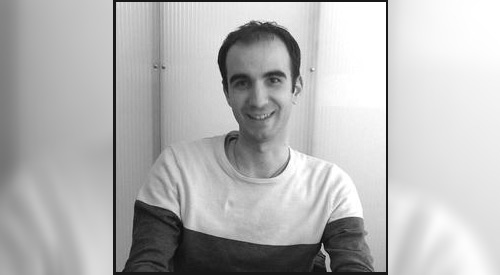The Falaki Gallery at the American University in Cairo is hosting an exhibition displaying the works of faculty members and guest artists. The gallery is a bit on the empty side though, compared to last year’s installment. Only the backroom of the gallery is being used for “Nearing Connections, where canvases sparingly adorn the walls.
The theme of the show is interweaving culture and dialogue in search of a deeper connection – which goes completely over my head.
Not to knock the displayed works, which clearly reflect diverse and creative techniques; it’s just that these connections are difficult to comprehend without a detailed walkthrough from the artists themselves.
The collection that first grabs your attention is “Japanese Lacquers by Marianne Rask. Hailing from Copenhagen, Rask is one of the exhibition’s most accomplished artists.
The square planks have a pearly shine to them. Bronze and green squares and lines come together on a black background, looking very Asian.
Another piece is starkly different, using earthy brown and beige tones with small patterns, which looks like an ant nest in the desert.
Other pieces are more modern, making use of bright green and orange patterns.
Brian Curling, director of the Falaki Gallery and a faculty member of the Performing and Visual Arts department, has his own work on display. One instillation called “Unwritten History of Mobility displays handmade books.
The first stack of books stands on a wooden stool, the empty papers tied together with strings. Three more stands are connected to each other with a thin rope. Strewn upon the floor are rows of open books, their pages blank. Also by Curling is a collection of distinctive drawings, highlighting the young professor’s penchant for drawing abstract trees. His images look as if they were drawn in pencil, and many of the pieces are a combination of lines and undefined dots. The background is painted white, adding texture to the original color of the paper.
One of his works, “The Place Ain’t the Same No More shows winter skeleton trees, following the same technique that gives the impression of a rainstorm.
The next set of works by Danish textile designer and weaver Isabel Masden displays colorful, woven square boards of linen, silk and Japanese paper.
The one that stands out shows two domes above the square, mimicking the silhouette of a Nubian architectural design. It may be pure coincidence that the colors she utilizes in this particular piece are those of the Egyptian flag: red, white, black and a golden yellow.
Perhaps the most representative of “connecting cultures is the work of AUC professor Gamal Lamie. His series “Dialogue among Civilizations uses mixed media: encaustic, handmade paper and paper cut-outs.
He displays an influence of Asian art, with cut-outs looking like Japanese dolls populating his work. Another piece is African inspired, looking quite Egyptian with a donkey (or perhaps a giraffe) in the center.
“The Dream of Peace is almost childlike in an enchanted magical way. Cut-outs of little boys on doves and young girls on flying fish inject the canvas with an intense sense of jubilation. Perhaps because that’s what peace is – a fairytale.
Another of Lamie’s collections mixes media as well as cultures. “Pray in India, Don’t Fight in Greece is a good example. As the name implies, the colorful painting shows little windows with black and white prints of Buddhas juxtaposed with images of warriors. Touches of Islamic art can also be observed in this work.
A table at the back of the hall displays the works of Francesca Pinol Torrent, a textile designer and professor of textile art at the Escola Massana in Barcelona. There’s something about the thread and needle work in her art that evokes images of a scene from Disney’s “Sleeping Beauty.
On the table lies silk, linen, crochet, copper and golden thread as well as a large sewing needle and another fancy gadget. This display is entitled, “The Thread of Life – deep.
Generally, the exhibition is fine to look at and makes up in technique what it lacks in overall concept.
Falaki GalleryThe American University in Cairo12-9 pm


